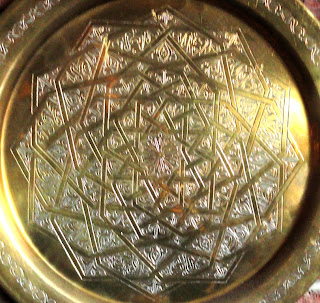At the very heart of the namesake poem "Pale Fire", in Vladimir Nabokov's most lapidary and perhaps most perfect novel of the same name, these lines crystallize, as it were, the wisdom of John Shade, the wise, gray poet protaganist of the poem (and part subject of the novel). These lines resonate whenever I see something like this dried up wetland at Bosque del Apache a few weeks ago:
"But all at once it dawned on me that this
Was the real point, the contrapuntal theme;
Just this: not text, but texture; not the dream
But topsy-turvical coincidence, ...."
Who isn't intrigued by the fractal patterns in nature--and the strange symmetry of cracking clay, or the basketweave pattern on a brass platter: I am entranced by the complicated patterning of faience or mosaic design. Fibonacci and Buckminster Fuller playing mental ping-pong.
"..Not flimsy nonsense, but a web of sense.
Yes! It sufficed that I in life could find..."
Yes! It sufficed that I in life could find..."

This recent trip was the first time I noticed that the forked footprints of cranes and other waterfowl helped instigate the cracking pattern of the clay.
Some kind of link and bobolink, some kind
Or correlated pattern in the game,
Plexed artistry..." (Pale Fire, Canto 3 line 806-815)
Or correlated pattern in the game,
Plexed artistry..." (Pale Fire, Canto 3 line 806-815)
The intricate patterning of marble tiles in Saint Marks, or the shimmering gold tesserae on a byzantine mosaic, or the rich colors of Oriental carpets or Victorian carpet bedding for that matter are ineluctible "decorations" that please me (and most observers) all out of scale to their belabored detail and lack of overt meaning. Likewise the repeated patterns of our lives, the habits in our home or garden, are the day to day weave of our lives that we take utterly for granted. But shift out of the ordinary: I'm completing a week of couch surfing and visiting friends and family in South California, and those day to day patterns are shattered. One can try to forge a new pattern while traveling, but it somehow isn't quite the same. Travel is rich, and rewarding--but for me it is most alluring knowing I shall be back in the encrusted, convoluted pattern of my day to day life in only a few more days. Back to my diurnal Escher tesselation!






Panayoti, How does fractal patterns or Fibonacci relate to the phenomena or items discussed in your blog post?
ReplyDeleteJames
Fractals and the fibonacci sequence that appear in many complex patterns (flower petals, plant growth patterns for instance) are examples of a complex order and sequencing that implies an underlying pattern in nature. In Pale Fire, Nabokov suggests that we can access an "other reality" by paying attention to the complex patterns within our own lives. Just as Jorge Luis Borges suggests that if you were to gaze at the pathways that you tread in your lifetime you would see that you have traced the outline of your very own face! It is all rather "woo woo" and abstact, but the gist of this sort of poetic thinking is that art (and the art I love the most tends to be highly patterned)is not just the distillation or lofty expression of life, but that it leads beyond this life somehow to a sort of eternity: for us art-for-art's sakers, one might say that art is not just divine but Divinity! Does that express it more clearly?
ReplyDeleteI was hoping for the mathematical formula. :)
ReplyDeleteJames